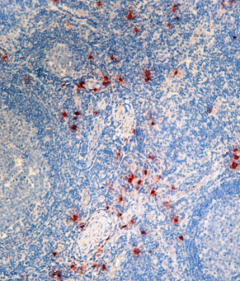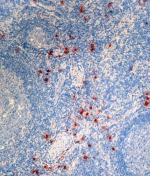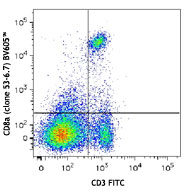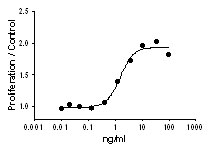- Clone
- AA1 (See other available formats)
- Regulatory Status
- RUO
- Other Names
- Tryptase-1, β-tryptase, tryptase alpha/beta-1, TPSAB1, TPS1, TPS2, TPSB1
- Isotype
- Mouse IgG1, κ
- Ave. Rating
- Submit a Review
- Product Citations
- publications

-

Human tonsil tissue was formalin fixed and paraffin embedded prior to sectioning. After deparaffinization and antigen retrieval with sodium citrate pH 6, the sample was stained overnight with anti-human Mast Cell Tryptase (clone AA1) at 10 µg/ml followed by detection using BioLegend's Ultra Streptavidin (USA) HRP detection kit. -

SeqIF™ (sequential immunofluorescence) staining on COMET™ of Purified anti-Mast Cell Tryptase (clone AA1, yellow) on formalin-fixed paraffin-embedded human head and neck squamous cell carcinoma (HNSCC) at 0.06 µg/mL. Alexa Fluor™ Plus 647 Goat anti-Mouse IgG antibody (Lunaphore, Cat. No. DR647MS) was used as a secondary antibody. Nuclei were counterstained with DAPI (blue). Tissue underwent an all-in-one dewaxing and antigen retrieval preprocessing.
| Cat # | Size | Price | Quantity Check Availability | Save | ||
|---|---|---|---|---|---|---|
| 369402 | 100 µg | 184€ | ||||
Mast Cell Tryptase (β-tryptase) is a neutral serine protease member of the peptidase family S1, composed of four subunits, each with a molecular weight of 32.5 kD. Mast cell tryptase has a role in inflammation and tissue remodeling. It also is a mediator in the pathogenesis of asthma and other allergic and inflammatory disorders by and its contribution to extracellular matrix-degrading processes.
Product DetailsProduct Details
- Verified Reactivity
- Human
- Reported Reactivity
- Monkey, Sheep, Pig, Cow, Dog, Cat
- Antibody Type
- Monoclonal
- Host Species
- Mouse
- Immunogen
- Human mast cell tryptase purified from lung tissue.
- Formulation
- Phosphate-buffered solution, pH 7.2, containing 0.09% sodium azide.
- Preparation
- The antibody was purified by affinity chromatography.
- Concentration
- 0.5 mg/mL
- Storage & Handling
- The antibody solution should be stored undiluted between 2°C and 8°C.
- Application
-
IHC-P - Quality tested
ICFC, ELISA, WB - Reported in the literature, not verified in house
SB - Community verified - Recommended Usage
-
Each lot of this antibody is quality control tested by immunohistochemistry. For immunohistochemistry, a concentration range of 1.0 - 10.0 µg/ml is suggested. It is recommended that the reagent be titrated for optimal performance for each application.
Tissue Sections: Formalin-fixed, paraffin-embedded tissue sections
Primary Antibody Incubation: 60 minutes at room temperature
Antigen Retrieval: Sodium citrate pH6 (Cat# 928601) - Application Notes
-
Additional reported applications (for the relevant formats of this clone) include: Mast cell tryptase detection in indirect ELISA1 and Western Blot1, immunohistochemical staining of acetone-fixed frozen tissue sections and formalin-fixed paraffin-embedded tissue sections2,3, and flow cytometric analysis of cells from bronchoalveolar lavage4.
We recommend using our Ultra Streptavidin (USA) HRP Detection Kit (Multi-Species) (Cat# 929601). - Additional Product Notes
-
For the use of this antibody in spatial biology applications, we have partnered with Lunaphore Technologies for demonstration of our antibodies on the COMET™. The COMET™ platform is an automated, end-to-end spatial biology solution developed for rapid and flexible multiplex tissue profiling. More information on the COMET™ and a complete list of our antibodies that have been demonstrated on the COMET™ can be found here.
-
Application References
(PubMed link indicates BioLegend citation) -
- Walls AF, et al. 1990. Clin. Exp. Allergy 20:581. (ELISA, WB)
- Walls AF, et al. 1990. J. Pathol. 162:119. (IHC)
- Berger P, et al. 1998. Am. J. Respir. Crit. Care Med. 157:610. (IHC)
- Redington AE, et al. 2000. Ann. Allergy Asthma Immunol. 85:501. (IHC, ICFC)
- Product Citations
-
- RRID
-
AB_2566541 (BioLegend Cat. No. 369402)
Antigen Details
- Structure
- Neutral serine protease, member of the peptidase family S1, and a tetramer with a molecular weight of approximately 132 kD.
- Distribution
-
Mast cells.
- Function
- Role in inflammation and tissue remodeling and may contribute to extracellular matrix-degrading processes.
- Cell Type
- Mast cells
- Biology Area
- Immunology, Innate Immunity
- Antigen References
-
1. Abdelmotelb AM, et al. 2014. Clin. Exp. Allergy 44:822.
2. Douaiher J, et al. 2014. Adv. Immunol. 122:211.
3. Moreno M, et al. 2014. PLoS One. 9:e97014.
4. Yavuz ST, et al. 2013. Allergy 68:386.
5. Mangia A, et al. 2011. Histopathology 58:1096. - Gene ID
- 7177 View all products for this Gene ID
- UniProt
- View information about Mast Cell Tryptase on UniProt.org
Related Pages & Pathways
Pages
Related FAQs
- If an antibody clone has been previously successfully used in IBEX in one fluorescent format, will other antibody formats work as well?
-
It’s likely that other fluorophore conjugates to the same antibody clone will also be compatible with IBEX using the same sample fixation procedure. Ultimately a directly conjugated antibody’s utility in fluorescent imaging and IBEX may be specific to the sample and microscope being used in the experiment. Some antibody clone conjugates may perform better than others due to performance differences in non-specific binding, fluorophore brightness, and other biochemical properties unique to that conjugate.
- Will antibodies my lab is already using for fluorescent or chromogenic IHC work in IBEX?
-
Fundamentally, IBEX as a technique that works much in the same way as single antibody panels or single marker IF/IHC. If you’re already successfully using an antibody clone on a sample of interest, it is likely that clone will have utility in IBEX. It is expected some optimization and testing of different antibody fluorophore conjugates will be required to find a suitable format; however, legacy microscopy techniques like chromogenic IHC on fixed or frozen tissue is an excellent place to start looking for useful antibodies.
- Are other fluorophores compatible with IBEX?
-
Over 18 fluorescent formats have been screened for use in IBEX, however, it is likely that other fluorophores are able to be rapidly bleached in IBEX. If a fluorophore format is already suitable for your imaging platform it can be tested for compatibility in IBEX.
- The same antibody works in one tissue type but not another. What is happening?
-
Differences in tissue properties may impact both the ability of an antibody to bind its target specifically and impact the ability of a specific fluorophore conjugate to overcome the background fluorescent signal in a given tissue. Secondary stains, as well as testing multiple fluorescent conjugates of the same clone, may help to troubleshoot challenging targets or tissues. Using a reference control tissue may also give confidence in the specificity of your staining.
- How can I be sure the staining I’m seeing in my tissue is real?
-
In general, best practices for validating an antibody in traditional chromogenic or fluorescent IHC are applicable to IBEX. Please reference the Nature Methods review on antibody based multiplexed imaging for resources on validating antibodies for IBEX.
Other Formats
View All Mast Cell Tryptase Reagents Request Custom Conjugation| Description | Clone | Applications |
|---|---|---|
| Purified anti-human Mast Cell Tryptase | AA1 | IHC-P,ICFC,ELISA,WB,SB |
Customers Also Purchased
Compare Data Across All Formats
This data display is provided for general comparisons between formats.
Your actual data may vary due to variations in samples, target cells, instruments and their settings, staining conditions, and other factors.
If you need assistance with selecting the best format contact our expert technical support team.
-
Purified anti-human Mast Cell Tryptase

Human tonsil tissue was formalin fixed and paraffin embedded... 
SeqIF™ (sequential immunofluorescence) staining on COMET™ of...
 Login / Register
Login / Register 











Follow Us